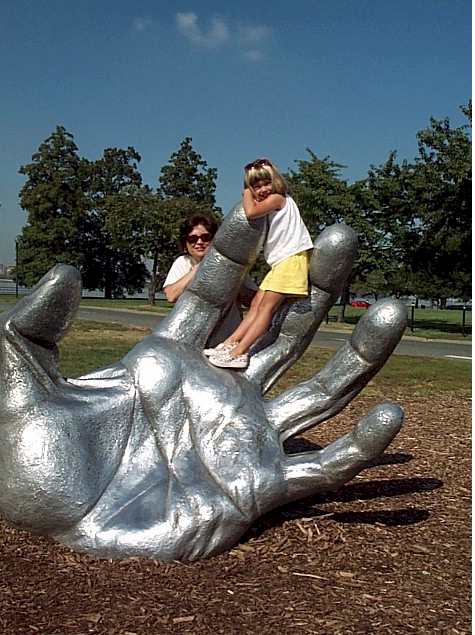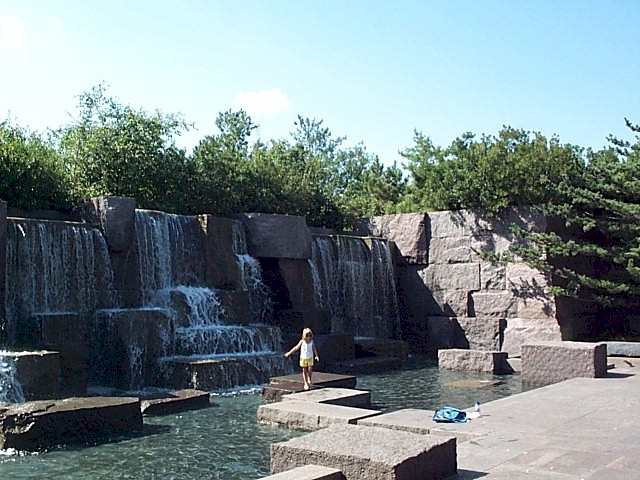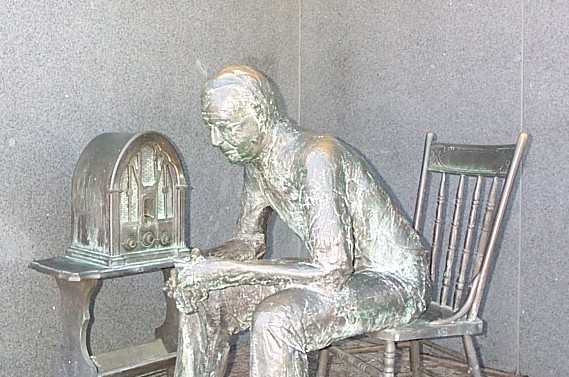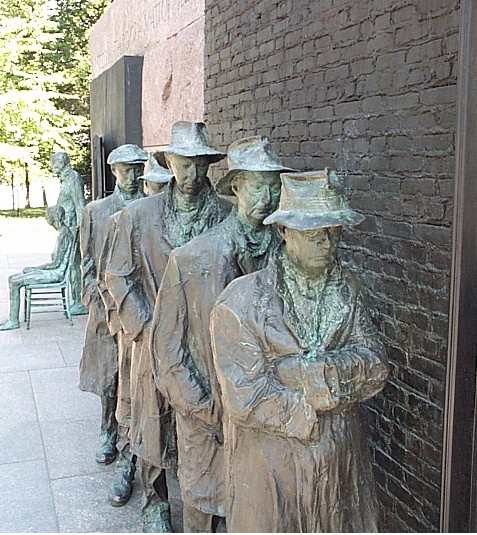September 29 - October 6 2000
Plans sometimes do work out. The plan was made to spend some time in Washington, D.C. where we could visit
Maria's niece and get a little culture. The sail from Solomons to the
mouth of the Potomac was a dream. The wind was behind us all the way; a
brilliant sun and relatively flat seas. The only drawback was our hasty
retreat from Solomons necessitated by the weatherman. We left on short
notice because we wanted to avoid 20+ knot winds forecast for the next day.
After our overnight on St George's Creek we left early for the first day of
our trip up the Potomac. We left our anchorage with 2 reefs in the main
and the genoa only partially unfurled. The apparent wind was just aft the
beam and close to 20 knots; and this in the protection of the Potomac. We
were glad we weren't out on the Bay. By the end of the day as we
approached the big bend in the Potomac at the Harry W. Nice Bridge we had shaken
out the reefs and had to turn on the motor. Just past the bridge we
anchored on the Port Tobacco River.
 Our
second day on the Potomac was entirely under power up to a small cove in the
shadow of the Woodrow Wilson Bridge. Along the way we passed Mount Vernon.
Washington's house is in the trees at the top of the hill in the photo, take my
word for it. We chose the anchorage near the bridge so that we would be only a
short distance from the bridge for its early morning opening. The Woodrow
Wilson Bridge only opens between midnight and 5 AM on weekdays and between
midnight and 7 AM on weekends. At that one must make a
"reservation" at least 12 hours beforehand. Our scheduled
opening was for 6:55 AM on Sunday.
Our
second day on the Potomac was entirely under power up to a small cove in the
shadow of the Woodrow Wilson Bridge. Along the way we passed Mount Vernon.
Washington's house is in the trees at the top of the hill in the photo, take my
word for it. We chose the anchorage near the bridge so that we would be only a
short distance from the bridge for its early morning opening. The Woodrow
Wilson Bridge only opens between midnight and 5 AM on weekdays and between
midnight and 7 AM on weekends. At that one must make a
"reservation" at least 12 hours beforehand. Our scheduled
opening was for 6:55 AM on Sunday.
The channel into our unnamed cove has no navigational buoys or other
marks. One gets in by turning to a compass heading of 64 degrees magnetic
at the "Red 90" buoy and proceeding for .7 miles. This is all
determined with parallel rules and dividers. Since the entrance is very
narrow and the water is only a couple of feet deep on either side it is very
anxiety producing. To get out in the semidarkness one just reverses the
course after getting up the anchor. Just to be sure of what we would be
doing I went out in the dinghy to do some soundings and later shot some headings
with my handheld compass. This seemed cheap insurance; if we ran aground
and missed our opening then we'd have to wait a day and do it at an even darker
hour.
Sunday Maria and I got up early and found clouds and some fog out on the
river. No problem, mon. We had done our homework. We got out
to the Red 90 and turned north for the bridge. As our appointed hour
approached the fog seemed to be rolling up the river from behind us. We
commented to each other on the difficulty that the two southbound boats would
have after clearing the bridge. Woe to us. No sooner were the words
out of our mouths and we had cleared the bridge than the fog completely
enveloped us. Within minutes visibility was cut to about 50 feet.
Since the channel markers are about 1/2 mile apart and we don't have radar we
had a serious problem.
Even with 50 feet of visibility we had no choice but to continue. On
the north side of the bridge the channel is rather narrow. Outside the
channel the river is only 2 - 4 feet deep. It is not until one gets up to
the city, 3.4 miles from the bridge, that there is any place to anchor or
dock. It took us two hours to traverse those few miles in the dark and the
fog. Our charts show us the compass headings through the channel.
Fortuitously we had spent some time the previous day comparing ADAGIO's compass
against the GPS and the charted course headings. We made our way by
carefully steering to the compass and paying careful attention to the depth
meter. Once one begins to deviate from the center of the channel the
bottom comes up very quickly. So we had to pieces of information to keep
us on course, the compass and the depth of the water. In this way we crept
up the river one buoy at a time. When we got just past the buoy marking
the separation of the channel into the Washington Channel and the Anacostia
River a few trees emerged from the fog. Given the depth of the water and
the last channel mark, we were confident that we were in the only place we could
safely stop before entering the Washington Channel. With our nerves frayed
we decided to drop the anchor and wait for the fog to lift.
 Once the fog lifted we made our way up to the Gangplank Marina. The view from
our backdoor includes the Washington Monument. You can see it peeking over
the buildings in the background. The marina includes many live-aboards.
They find that they can get more living space at lower cost per square foot by
living on a boat than by living on land. Well, in some cases it is being
generous to characterize these residences as boats. The two gray
structures at the right of the photo are not much more than mobile homes on a
floats. There are some other wooden relics that clearly haven't left their
slip in years.
Once the fog lifted we made our way up to the Gangplank Marina. The view from
our backdoor includes the Washington Monument. You can see it peeking over
the buildings in the background. The marina includes many live-aboards.
They find that they can get more living space at lower cost per square foot by
living on a boat than by living on land. Well, in some cases it is being
generous to characterize these residences as boats. The two gray
structures at the right of the photo are not much more than mobile homes on a
floats. There are some other wooden relics that clearly haven't left their
slip in years.
You're probably all tired of the usual photos of the popular monuments in
Washington. Diana chose to visit East Potomac Park on our first day.
In the following photos you can see Maria and Diana on hands-on sculpture titled
"The Awakening". From there we rode our bikes on to the
Jefferson Monument and FDR Memorial.
The former is well known and often photographed so I include pictures of the
FDR Memorial instead.
In the vicinity of the FDR Memorial we looked for the Japanese Pagoda and
Lantern. Japan is a segment of Diana's first grade curriculum at Glenside
Elementary so we had high hopes. Our expectations were not
fulfilled. The "Pagoda" is just a small granite sculpture.
The Lantern is of the sort that one might find in the older sections of a
Japanese garden. Since there were no tablets explaining the items there
really was a rather short lesson.
On 10/3 we went to the Washington Monument. Diana actually liked the
panoramic scene from the top. It was made more enjoyable by the presence
of a little boy who shared the excitement with her. After the monument we
went to the Museum of American History. With a 6 year old in tow it isn't
possible to linger over the individual exhibits. In fact, it is all just a
blur.
Wednesday we went our separate ways. Christopher hopped a train to go
visit his girlfriend for a few days. Diana and Maria went to the
Children's Museum. This museum was a big hit with her. There were
lots of opportunities for hands on activity. I went to the National
Galleries. The highlight of the west building was the exhibit of
architectural models, drawings and paintings from the Baroque period. Over
the years I have seen many of the featured buildings in the flesh, so to
speak. At the end of the day the three of use had dinner with Maria's
niece.
In preparation for pushing south we spent Thursday morning at the grocery
store. In the afternoon Maria "went to the office,"
virtually. Diana and I spent the afternoon at the Museum of Natural
History. As with most small children the dinosaurs and fossils were a big
hit. We also stopped in the galleries devoted to ancient Egypt.
Diana is fascinated by things Egyptian so this part of the museum was not a hard
sell. As we sat and watched several short videos about the cultural
history of Egypt Diana lost her second tooth so we had to rush back to the boat.
Our last day in the D.C. area included last minute laundry and stowing
miscellaneous things in their homes on the boat. About noon we headed down
the Potomac to Alexandria for an overnight at the City Marina. Had we
known how interesting waterfront Alexandria is then we would have planned for
more time here. There are many fine arts galleries, including several
floors in the old Torpedo Factory. And the restaurants probably outnumber
the number of residents.
Early on the morning of 10/7 we begin the passage south with a 6:45 AM
opening of the Woodrow Wilson Bridge for us and a couple of other
sailboats.
 Our
second day on the Potomac was entirely under power up to a small cove in the
shadow of the Woodrow Wilson Bridge. Along the way we passed Mount Vernon.
Washington's house is in the trees at the top of the hill in the photo, take my
word for it. We chose the anchorage near the bridge so that we would be only a
short distance from the bridge for its early morning opening. The Woodrow
Wilson Bridge only opens between midnight and 5 AM on weekdays and between
midnight and 7 AM on weekends. At that one must make a
"reservation" at least 12 hours beforehand. Our scheduled
opening was for 6:55 AM on Sunday.
Our
second day on the Potomac was entirely under power up to a small cove in the
shadow of the Woodrow Wilson Bridge. Along the way we passed Mount Vernon.
Washington's house is in the trees at the top of the hill in the photo, take my
word for it. We chose the anchorage near the bridge so that we would be only a
short distance from the bridge for its early morning opening. The Woodrow
Wilson Bridge only opens between midnight and 5 AM on weekdays and between
midnight and 7 AM on weekends. At that one must make a
"reservation" at least 12 hours beforehand. Our scheduled
opening was for 6:55 AM on Sunday. Once the fog lifted we made our way up to the Gangplank Marina. The view from
our backdoor includes the Washington Monument. You can see it peeking over
the buildings in the background. The marina includes many live-aboards.
They find that they can get more living space at lower cost per square foot by
living on a boat than by living on land. Well, in some cases it is being
generous to characterize these residences as boats. The two gray
structures at the right of the photo are not much more than mobile homes on a
floats. There are some other wooden relics that clearly haven't left their
slip in years.
Once the fog lifted we made our way up to the Gangplank Marina. The view from
our backdoor includes the Washington Monument. You can see it peeking over
the buildings in the background. The marina includes many live-aboards.
They find that they can get more living space at lower cost per square foot by
living on a boat than by living on land. Well, in some cases it is being
generous to characterize these residences as boats. The two gray
structures at the right of the photo are not much more than mobile homes on a
floats. There are some other wooden relics that clearly haven't left their
slip in years. 




